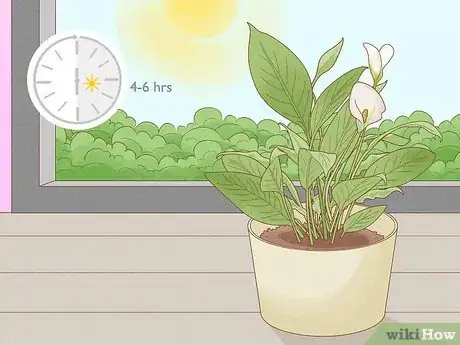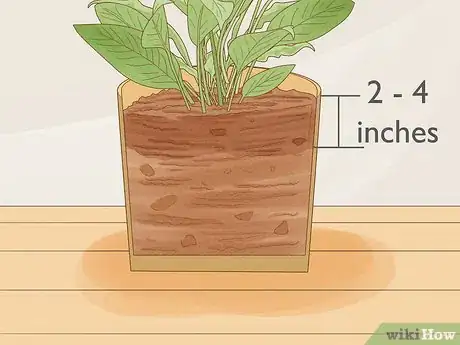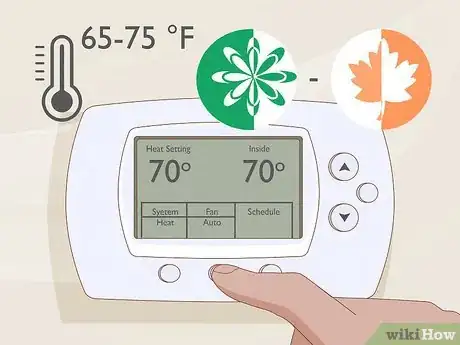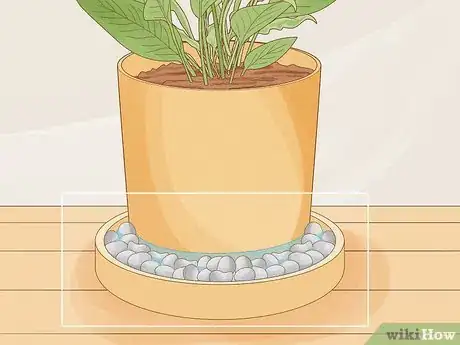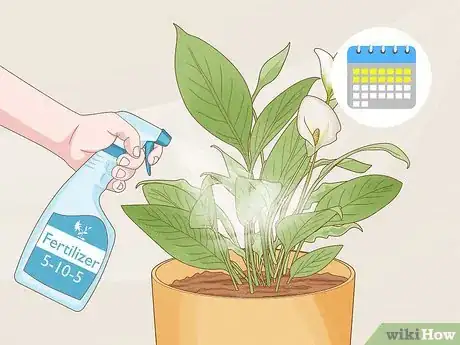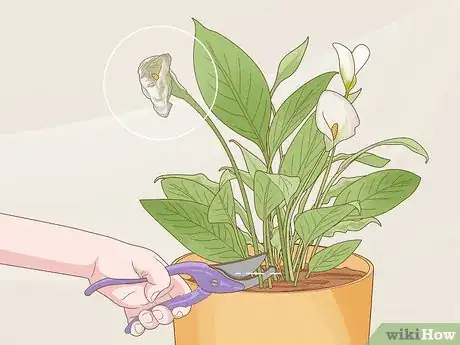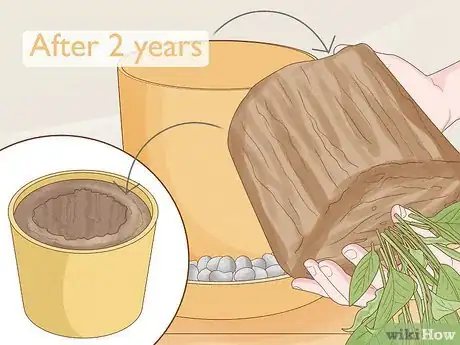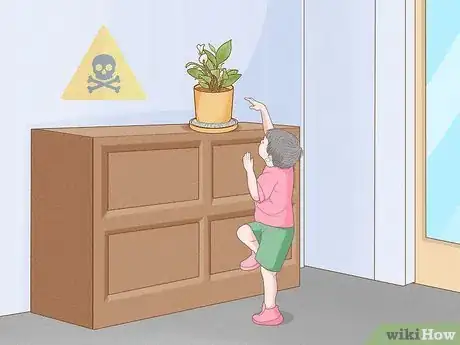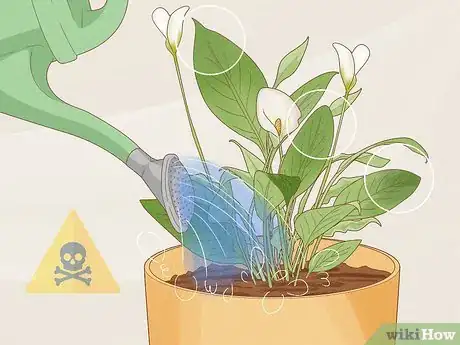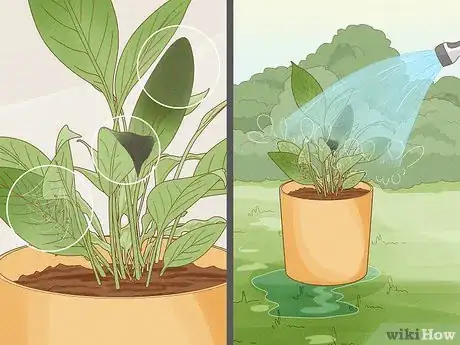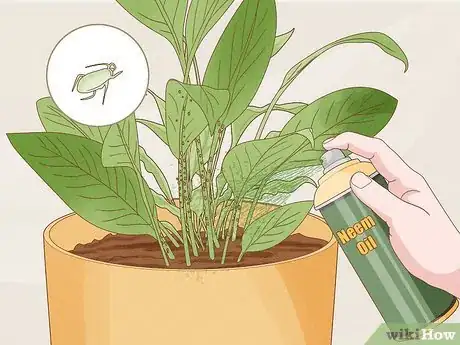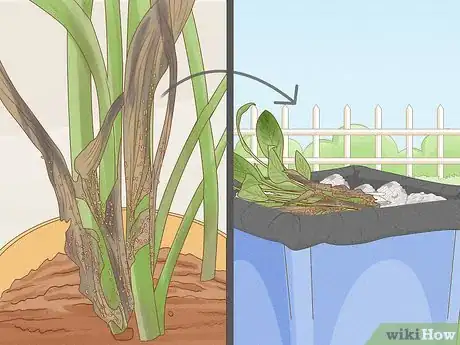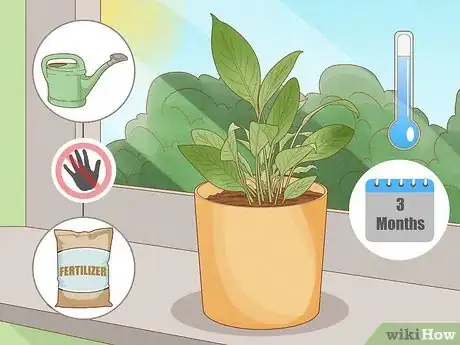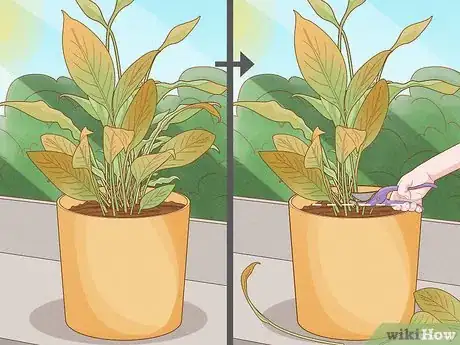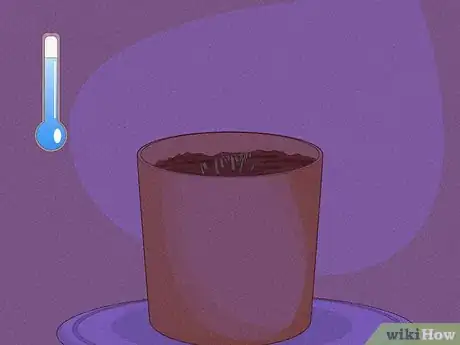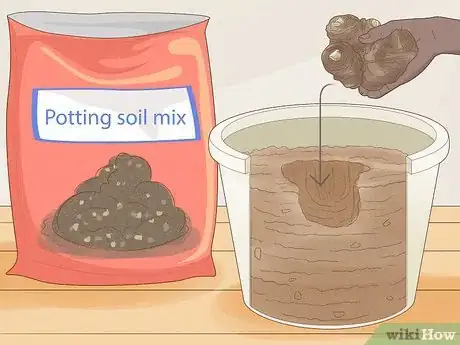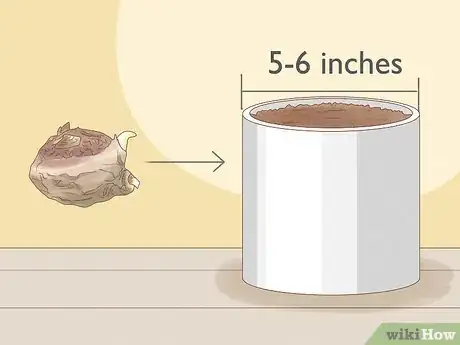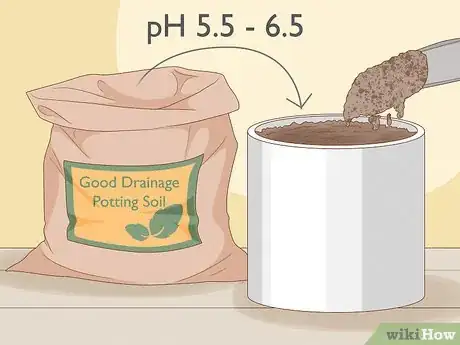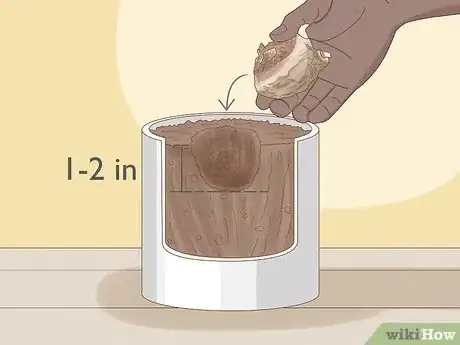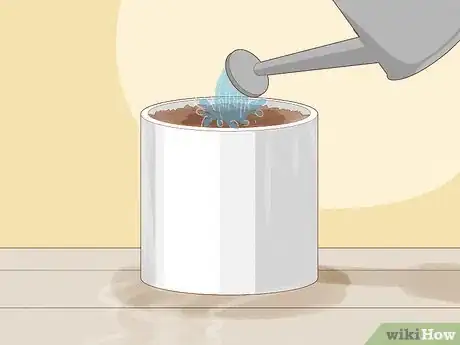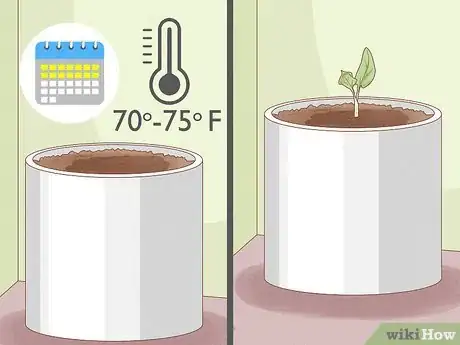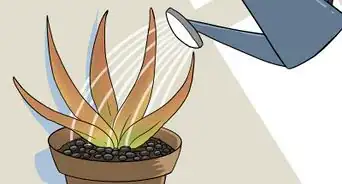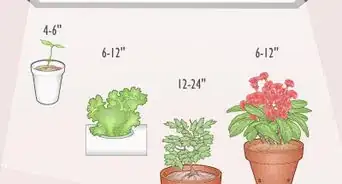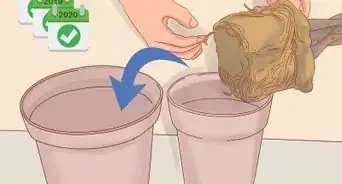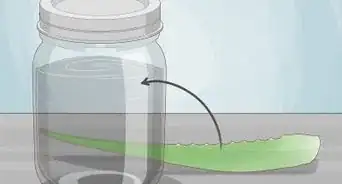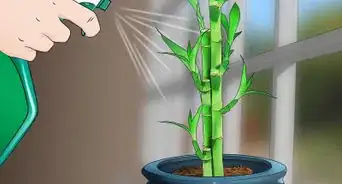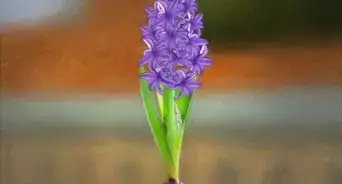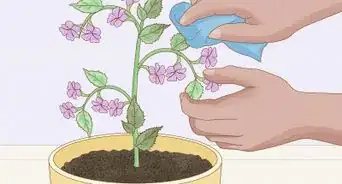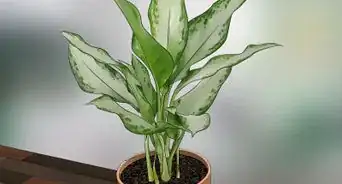This article was co-authored by Jon Rowland and by wikiHow staff writer, Amy Bobinger. Jon Rowland is a Plant Specialist and the Founder of the Green House Center blog. With over eight years of plant and garden experience, he specializes in greenhouse care, lawn and garden maintenance, and home appliance recommendations. Jon aims to share his knowledge so that others can live a more convenient, efficient, and environmentally friendly lifestyle.
There are 19 references cited in this article, which can be found at the bottom of the page.
This article has been viewed 26,699 times.
Calla lilies make a strikingly beautiful houseplant. Even better, they're pretty low-maintenance, and with a little care they'll come back year after year. Whether you've been given a calla lily as a gift or you're hoping to grow a new plant from a bulb, we have all the tips you need to grow and care for a calla lily indoors.
Steps
Basic Indoor Calla Lily Care
-
1Place your calla lily where it gets 4-6 hours of light a day. Calla lilies like it bright, so pick a sunny spot near a window or a glass door. However, avoid an area where the sun beams straight in, especially at mid-day. Direct sunlight can burn the leaves and flowers, causing them to turn yellow.[1]
- If the area where you put the plant is too dim, your calla lily may be smaller and the flower stem may not be as strong.[2]
-
2Keep the soil moist during the growing season. Every few days from spring through fall, stick your finger into your plant's soil to see how damp it is. If it's dry down to about 2–4 in (5.1–10.2 cm), water the calla lily until the soil is completely moist.[3] In general, your calla lily will do best if you keep it watered regularly. If you let it dry out too much, it may start to yellow and droop, and the flowers won't look as vibrant.[4]
- Don't oversaturate the plant, though—this will lead to root rot. If the top 2–4 in (5.1–10.2 cm) of the soil still seems moist, you don't need to water your calla lily yet.
Advertisement -
3Set your thermostat to 65–75 °F (18–24 °C) from spring through fall. Calla lilies actually do really well at normal room temperature, which is part of their appeal as houseplants. However, do your best to keep the temperature pretty consistent—big swings throughout the day can affect how well your plant will flower.[5]
- Keep your plant away from heating and air conditioning vents, as these areas tend to have more fluctuations in temperature.
-
4Place a humidity tray under the plant if you live in a dry climate. Calla lilies prefer an environment with about 40% relative humidity. If your air is drier than that, fill a shallow tray with smooth pebbles, then add enough water to the tray so the bottom is covered but the pebbles aren't totally submerged. Place your calla lily on top of the pebbles—as the water evaporates from the tray, it will moisten the air, helping your plant thrive.[6]
- Add more water to the tray every few days or whenever it dries out.
- You can also mist your calla lily with a fine spray of water every few days if you don't want to make a humidity tray.
- Alternately, you could run a cool-mist humidifier to keep the air in your home from drying out.[7]
-
5Fertilize your calla lily every 2 weeks with liquid fertilizer. Calla lilies require a lot of nutrients in their soil, so they do best with regular feeding. Choose a 5-10-5 or 5-10-10 liquid fertilizer, which contains 5% nitrogen, 10% phosphorous, and 5% or 10% potassium. These should be safe to use every other week during the growing season.[8] Follow the label instructions for how to apply the fertilizer—usually you'll mix them in water and pour the mixture onto the soil.
- Once your flowers have faded, stop fertilizing the plant.[9]
-
6Cut back the stems after your flowers fade. Eventually, the blooms on your calla lily will start to wilt and turn brown. When that happens, use shears to snip the flower stem close to the base of the plant.[10]
- This is mostly just for aesthetic purposes, so you don't have an unsightly dead flower or wilted stem in the middle of your plant.
-
7Repot your plant every 2 years or when it looks root-bound. Eventually, your calla lily will grow out of its pot. Choose a new pot that's just a little larger than the root ball. Lift the calla lily gently out of its old pot and carefully place it in the new pot. Fill the pot with a well-draining potting soil, and give the plant a little extra water for a few days after you replant it.[11]
- Take care not to damage the roots when you transfer the plant.
-
8Keep your calla lily out of the reach of kids and pets. Every part of your calla lily is toxic, from the rhizomes and roots to the leaves and flowers. If you have small children or pets who might try to eat the plant—or even just play with it—keep it on a high surface in an out-of-the-way place.[12]
- If a child or animal does put the calla lily in their mouth, you might notice drooling and swelling of the lips, tongue, or throat. They might also have stomach pain and diarrhea.
- Call poison control or seek emergency care if you suspect calla lily poisoning.
Calla Lily Pests and Diseases
-
1Cut back on watering or fertilizing if the leaves have dark tips. It can be hard to figure out exactly which one is causing the problem because the results look the same. However, if you've recently started fertilizing your plants more often (or you've switched to a new fertilizer), this could be the culprit. Same for if you've recently changed your watering schedule.[13]
- If you're still not sure, give the plant a little break from both fertilizing and watering. Wait until the soil is dry to about 4 in (10 cm) before you water it again, and skip fertilizing for 3-4 weeks.
-
2Check for spider mites if the leaves look gray. These tiny mites will feed on your calla lily, gradually causing the leaves to take on a yellowish-gray color. Luckily, it's pretty easy to remove these mites—just take the plant outside and spray the plant with water.[14]
- You might need to repeat this a few times if the mites reappear.
-
3Spray the plant with neem oil if you spot aphids. Aphids, also known as plant lice, are another pest that might feed on your calla lily. Aphids are tiny insects with soft bodies, and you will usually see them in clusters.[15] To prevent them, lightly spritz the leaves of your calla lily with neem oil every 1-2 weeks.[16]
- If you prefer, you can spray the plant once a week with insecticidal soap, instead.
-
4Destroy the plant if you notice stem rot or ring mosaic virus. These illnesses can spread to other plants, and there's no way to heal the plant once they form. Wear gloves and pull the plant up from its pot, then toss the whole plant in the trash. To be safe, it's probably best not to reuse the soil that the plant was in.[17]
- If your plant has stem rot, the stem will start to look soft and mushy, and your plant may start to lean over.
- If it has ring mosaic virus, you'll notice a yellow discoloration that looks like stripes or spots on the leaves and stems.
Wintering Calla Lillies
-
1Stop watering and feeding the plant each winter. This will give your calla lily a chance to rest for 2-3 months, and it's an important process if you want to keep your calla lily for more than one season. Give your plant a winter break even if you live in a climate where it doesn't get very cold. If you don't winter your plant, it won't bloom as well the next year, and it might not be as healthy overall.[18]
- Although you can stop fertilizing the plant as soon as the blooms wilt, it's best to gradually decrease how often you water the plant rather than stopping abruptly.[19]
-
2Cut the plants all the way down to the soil once they turn yellow. The cooler temperatures combined with the lack of water and food will cause your plant to wilt. Don't panic—that's actually what you're going for. Once the leaves turn yellow or brown and start to droop, use a sharp pair of shears to trim them all the way down to the soil.[20]
- Your plant will grow new, healthy leaves in the spring.
-
3Place the pot somewhere cool and dark. It's fine to leave the rhizomes in the pot after you cut the leaves back. Just put the whole container somewhere that will stay around 40–60 °F (4–16 °C), like a cellar.[21]
- Some gardening experts recommend adding just a little water to the soil every so often so the tubers don't dry completely out.
-
4Repot the rhizomes in fresh soil between January and March. Your calla lily will be healthiest if you replant the rhizomes—sometimes called the tubers—each year in the early spring. Pull the rhizomes out of the soil—they'll probably look like one big clump, but this is typically divided into several smaller sections, each with its own bud. Use sharp scissors to snip apart these individual rhizomes.[22] Then, replant the biggest rhizomes in fresh potting soil, as these will produce the strongest plants.[23]
- The buds, also called eyes, will look like a small pointed tip on the rhizome.[24]
- Even if you're planning to grow your calla lilies indoors, it's best to start them about a month before your last frost.
- If you don't divide the rhizomes, your calla lily will probably be too big for its pot. It might be less healthy as it grows, and it may have trouble standing upright.
Potting the Rhizomes
-
1Choose a 5–6 in (13–15 cm) diameter pot for a single bulb. This size pot will look nice with a single calla lily plant growing out of it. In addition, it will provide plenty of room for the roots to spread out.[25]
- If you want to plant more than one bulb in a single container, use a planter that's 8 in (20 cm) or larger in diameter.
- Make sure your container has drainage holes or the roots of your plant will become waterlogged and rot.[26]
- Use the same size pot whether you're planting a new calla lily bulb or you're replanting one you separated after wintering.
-
2Fill the container with potting soil that drains well. There are a lot of different combinations of potting soil you could use, but in general, it's best to start with one that has a peat moss base. These types of soil can stay moist without holding on to excess moisture that could rot the roots of your calla lily.[27]
- Try using a potting mix that's made of equal parts peat moss and perlite.
- Test the soil pH to make sure it's slightly acidic—between 5.5 and 6.5 pH—and adjust it if you need to.
-
3Place the calla lily rhizome in a hole 1–2 in (2.5–5.1 cm) deep. Dig a shallow hole with your fingers, then place the rhizome inside this hole with the bud facing straight up. Then, cover it with soil so the very top of the rhizome is just barely showing above the surface of the dirt.[28]
-
4Water the plant well after you pot it. Freshly-potted plants usually need a lot of water, and your calla lily is no exception. Give it a generous amount of water, but not so much that the water floods the pot.[31]
- Make sure the potting mix stays damp through the growing process.
-
5Keep the pot in a spot that stays between 70–75 °F (21–24 °C). The warmer temperatures will signal the plant that winter is over. Within about 2 weeks, you should see the first shoots starting to appear.[32]
- If the spot you chose doesn't get much sun, move the pot to a sunnier location once the shoots start to grow.
- Your calla lily should start to flower about 13-16 weeks after you repot the rhizome, depending on the type of plant you have and the general growing conditions.
Expert Q&A
-
QuestionWhat do you do with indoor calla lilies after they bloom?
 Lindsey SwettLindsey Swett is a Plant Specialist and the Owner of Niche Plant Shop in Boston, Massachusetts. She has over a decade of experience working in several plant settings, including golf courses, public parks, and commercial garden centers. Her focus now is on helping plant owners care for their indoor plants. Lindsey holds a Master of Landscape Architecture from The University of Michigan.
Lindsey SwettLindsey Swett is a Plant Specialist and the Owner of Niche Plant Shop in Boston, Massachusetts. She has over a decade of experience working in several plant settings, including golf courses, public parks, and commercial garden centers. Her focus now is on helping plant owners care for their indoor plants. Lindsey holds a Master of Landscape Architecture from The University of Michigan.
Plant Specialist These flowers are usually given as gifts during Easter time, so they normally have blooms already, and that will fade within a couple of months. Since it's already in bloom, I would simply put it in bright light. That said, avoid anything too hot, because the idea is to preserve the flower as long as you can and try and make it last a little longer.
These flowers are usually given as gifts during Easter time, so they normally have blooms already, and that will fade within a couple of months. Since it's already in bloom, I would simply put it in bright light. That said, avoid anything too hot, because the idea is to preserve the flower as long as you can and try and make it last a little longer.
References
- ↑ https://www.lsuagcenter.com/profiles/rbogren/articles/page1581092962808
- ↑ https://hort.ifas.ufl.edu/floriculture/pdfs/crop_production/Callas_ENHFL04-001.pdf
- ↑ https://hort.ifas.ufl.edu/floriculture/pdfs/crop_production/Callas_ENHFL04-001.pdf
- ↑ https://www.gardenia.net/guide/learn-how-to-plant-and-care-for-your-calla-lilies
- ↑ https://hort.ifas.ufl.edu/floriculture/pdfs/crop_production/Callas_ENHFL04-001.pdf
- ↑ https://beangrowing.com/revive-a-dying-calla-lily/
- ↑ https://www.guide-to-houseplants.com/pink-calla-lily.html
- ↑ https://extension.umn.edu/flowers/calla-and-canna-lilies
- ↑ https://www.gardenia.net/guide/learn-how-to-plant-and-care-for-your-calla-lilies
- ↑ https://www.gardenia.net/guide/learn-how-to-plant-and-care-for-your-calla-lilies
- ↑ https://plantingman.com/crystal-blush-calla-lily/
- ↑ https://plants.ces.ncsu.edu/plants/zantedeschia/
- ↑ https://plantingman.com/crystal-blush-calla-lily/
- ↑ https://plantcaretoday.com/growing-calla-lily-plant-bulbs.html
- ↑ https://www.almanac.com/pest/aphids
- ↑ https://plantcaretoday.com/growing-calla-lily-plant-bulbs.html
- ↑ https://plantcaretoday.com/growing-calla-lily-plant-bulbs.html
- ↑ https://plantcaretoday.com/growing-calla-lily-plant-bulbs.html
- ↑ https://www.guide-to-houseplants.com/pink-calla-lily.html
- ↑ https://www.guide-to-houseplants.com/pink-calla-lily.html
- ↑ https://www.guide-to-houseplants.com/pink-calla-lily.html
- ↑ https://www.guide-to-houseplants.com/pink-calla-lily.html
- ↑ https://hort.ifas.ufl.edu/floriculture/pdfs/crop_production/Callas_ENHFL04-001.pdf
- ↑ https://extension.umn.edu/flowers/calla-and-canna-lilies
- ↑ https://plantcaretoday.com/growing-calla-lily-plant-bulbs.html
- ↑ https://www.mygardenlife.com/plant-library/2466/zantedeschia/rehmannii
- ↑ https://hort.ifas.ufl.edu/floriculture/pdfs/crop_production/Callas_ENHFL04-001.pdf
- ↑ https://hortnews.extension.iastate.edu/faq/when-can-i-start-calla-lilies-indoors
- ↑ https://www.gardenia.net/guide/learn-how-to-plant-and-care-for-your-calla-lilies
- ↑ https://thepracticalplanter.com/why-are-my-calla-lilies-drooping/
- ↑ https://hortnews.extension.iastate.edu/faq/when-can-i-start-calla-lilies-indoors
- ↑ https://hortnews.extension.iastate.edu/faq/when-can-i-start-calla-lilies-indoors
- ↑ https://plantcaretoday.com/growing-calla-lily-plant-bulbs.html
